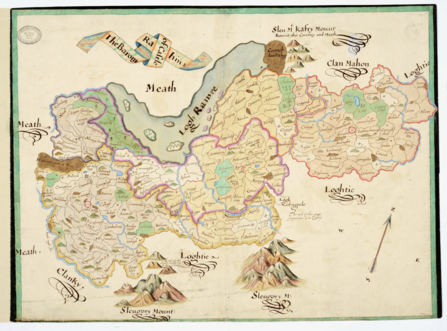Back

Collections
Ireland, Maps and Surveys 1558-1610
Chartography had a key role to play in the creation of the British Empire for use by the military and social engineers alike. The collection consists of 68 beautifully illustrated maps of Ireland from the late 16th and early 17th centuries. It includes browsable maps from famous cartographers Robert Lythe, Francis Jobson, Richard Bartlett and John Norden.

- Date range
- 1558-1610
- Records
- 68
- Images
- 68
About this collection
In this collection, Findmypast have digitised the early Irish maps from The National Archives series ‘State Papers Ireland’. The maps were created during the reign of Elizabeth I and James I. They assisted the English in the conquest and plantation of Ireland, a time when the English crown confiscated Irish lands and redistributed the land to English planters or settlers. Most of the land confiscated had belonged to Gaelic leaders in Munster, Ulster and elsewhere.
These beautifully decorated maps were used to inform settlers of the locations of rivers, bogs, fortifications and harbours. In some illustrations, you’ll find drawings of wildlife and even sea monsters. Around the harbours, the cartographers took the time to draw ships with cannons and sailors. Many of the maps also detail the names of Gaelic clans and the lands they owned, for example O’Hanlan in Armagh, O’Neill in Tyrone and O’Connor in Roscommon.
At this time, professional mapmaking was in its early stages, with common standards not yet established. You’ll see that North isn’t at the top in many of the maps – you can use the rotation option on the image to spin it to the correct orientation, with North at the top.
Mapmaking was a dangerous career during this period. The cartographers were exploring hostile foreign territory. One of the creators of these maps, Richard Bartlett, was beheaded in Tyrconnell, Donegal, by locals who were resisting the English plantation and did not want the English government to own maps of their lands.
Names of maps:
- Athenry, County Galway
- Banagher, County Offaly
- Bantry Bay, County Cork & County Kerry
- Barony of Armagh, County Armagh
- Barony of Castlerahan, County Cavan
- Barony of Clanawley, County Fermanagh
- Barony of Clankee, County Cavan
- Barony of Clankelly, County Fermanagh
- Barony of Clanmahon, County Cavan
- Barony of Clogher, County Tyrone
- Barony of Fews, County Armagh
- Barony of Idrone, County Carlow
- Barony of Loughtee, County Cavan
- Barony of Lurg, County Fermanagh
- Barony of Magheraboy, County Fermanagh
- Barony of Magherastephana, County Fermanagh
- Barony of Omagh, County Tyrone
- Barony of Orior, County Armagh
- Barony of Tiranny, County Armagh
- Barony of Tullygarvey, County Cavan
- Barony of Tullyhaw, County Cavan
- Barony of Tullyhunco, County Cavan
- Belfast Lough
- Blackwatertown, County Armagh
- Carrickfergus, County Antrim
- Castlemaine, County Kerry
- County Limerick
- County Mayo from Killala Bay to Inishbofin Island
- County Mayo & County Sligo
- County Monaghan
- County Sligo & County Leitrim
- County Wicklow & County Ferns (Parts of the modern counties of Wexford, Wicklow, Carlow & Dublin)
- Coast of County Antrim
- Coast of County Down from Lough Strangford to Carlingford
- Coast of Ireland from Carrickfergus to Dundrum Bay
- Coast of Ireland from Dublin to Carrickfergus
- Coast of Munster from Kinsale & Dingle
- Corkbeg Fort, County Cork
- Enniskillen, County Fermanagh
- Ireland
- Kinsale, County Cork
- Limerick, County Limerick
- Lough Erne, County Fermanagh
- Lough Neagh, County Antrim
- Newry Castle, County Down
- Newry, County Down
- North-East Ulster
- North-West Coast of Ulster
- Part of Barony of Dungannon, County Tyrone
- Part of Barony of Knockninny, County Fermanagh
- Part of Barony of Loghinisholin, County Londonderry
- Part of Barony of Oneilland, County Armagh
- Part of Barony of Strabane, County Tyrone
- Portrush, County Antrim
- Province of Munster
- Province of Munster (Except County Clare)
- Province of Ulster
- Roscommon, County Roscommon
- Smerwick Harbour, County Kerry
- Southern Ulster
- The National Archives, Kew, London, UK
Try the Social History Archive.